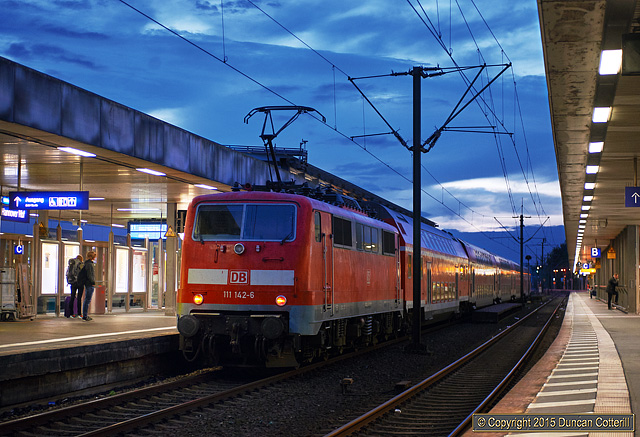HAMBURG & HANNOVER
Short Visits To Two Of North Germany's Main Rail Centres
Germany - 22 & 25 September and 01 & 06 October 2015 - Report by Duncan Cotterill
INTRODUCTION
Hamburg and Hannover are two of northern Germany's main rail centres and were visited briefly in late September and early October 2015. This report details observations on three days in the Hamburg Area and one day travelling the Hannover - Göttingen and Hannover - Osnabrück lines.Hamburg Hbf
Hamburg Hbf was a difficult station to photograph with lots of poles in awkward places. The south eastern exit from the station was reasonably uncluttered with a convenient low railing allowing departing trains to be photographed from Münzstrasse. The biggest problem was that the interesting stuff, loco worked services to and from Lübeck, Bad Oldesloe etc, tended to use the near tracks.112.173 left with RE21414, the 11:04 to Lübeck, paralleled by a class 474 EMU on an S1 service to the airport on 1 October 2015. In between the departing trains, the rear end of ICE1516, recently arrived from Eisenach, can just be seen.
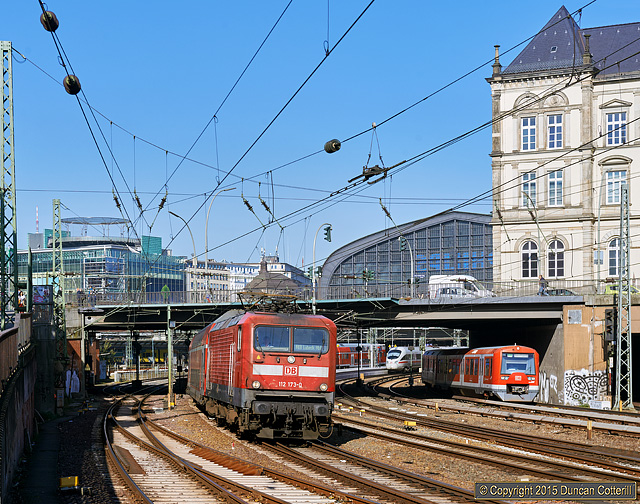
HAMBURG AREA
22, 25 September & 01 October 2015I visited Hamburg on the way to and from the north end of the Marschbahn at the end of September 2015 and also for one day during the trip. The Niebüll - Westerland element of the trip is covered in a separate report. The idea was to photograph regional services around Hamburg Hbf where most trains are still operated by locomotives and push-pull sets. In the event photography turned out to be rather difficult and very few good photos were obtained.
Local services around Hamburg fall neatly into three categories; the Hamburg S-Bahn, regional services to destinations in Schleswig-Holstein or beyond into the former DDR and regional services to destinations in Niedersachsen. Hamburg S-Bahn is a DB subsidiary company, distinct from DB Regio, and operates entirely with EMUs. At least they're quite interesting EMUs as these things go, collecting current from a 1200V bottom contact third rail. Two classes of 3-car EMU are currently in service, class 472s dating from the 1970s and class 474s built from the mid-1990s onwards. Subclass 474.3 are equipped with pantographs as well as collector shoes so they can operate beyond the third rail on lines electrified with the standard 15kV overhead equipment.
Most Schleswig-Holstein regional services from Hamburg are operated by electric locos on push-pull sets, usually but not always double deckers. Locos seen are listed below :
- REs to Kiel had a class 112 leading from Hamburg - 112.142 / 150 / 154
- REs to Flensburg had a class 112 leading from Hamburg - 112.163 / 172
- REs to Lübeck had a class 112 leading from Hamburg - 112.140 / 141 / 142 / 147 / 150 / 168 / 173
- RBs to Ahrensburg, Bargteheide or Bad Oldesloe had a class 112 or 143 leading from Hamburg - 112.158 / 160 / 172 / 181, 143.163 / 311 / 314 / 839
- REs to Büchen had a class 143 leading from Hamburg - 143.314
- REs to Schwerin or Rostock usually had a class 120 pushing from Hamburg - 120.203 / 204 - one train was seen with a 112 or 143 substituting for the 120.
- IREs to Berlin weren't seen but 182.024 was stabled on the stock (hauled, not push-pull) at Eidelstadt on two occasions.
- Local services to Itzehoe and Wrist were operated by Nordbahn class 1429 and 1430 Flirt EMUs.
As would be expected, Hamburg is served by many InterCity services, both ICEs and loco and coaches. Many of the latter were operated with push-pull equipment and the vast majority were powered by class 101s although a few class 120s were also seen. The most interesting ICs from my perspective were the through services to Fehmarn-Burg, north of Lübeck on the line to Puttgarden, worked from Hamburg Hbf by a class 218 diesel. These only ran until 28 September. On 25 September 218.307 worked IC2327 IC2220 and IC2221 in push-pull mode, pulling from Hamburg. This was a bit of a surprise as everywhere else I'd seen 218s on ICs they had always pulled even when the stock included a driving trailer.
Of less interest but also worthy of note were the InterCity services to Denmark. I knew that class 605 diesel ICEs were being used on services between Hamburg and Copenhagen via the Puttgarden - Rødby ferry but hadn't realised they were also being used on trains running via Flensburg as well. ICE38 from Copenhagen and ICE381 from Aarhus, each formed of a class 605 unit were seen coupled together departing for Berlin. In the other direction ICE35 to Copenhagen and ICE380 to Fredericia arrived from Berlin coupled together and then went their separate ways.
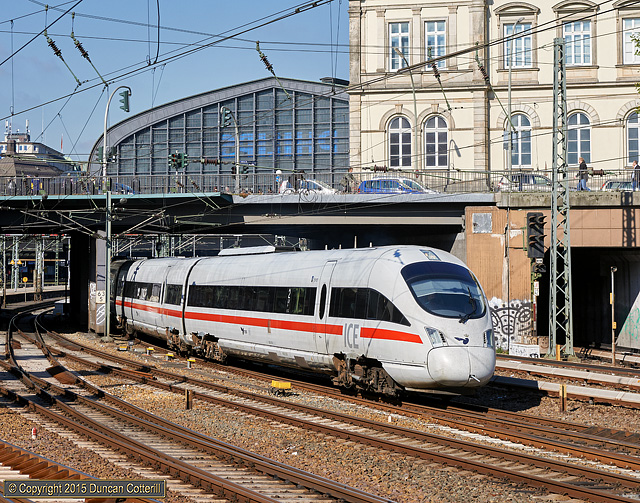
Danish Diesel ICE
605.020 wore DSB's crowned tadpole on its nose and flanks but its EVN still had a "D-DB" suffix indicating its true nationality and owner. The unit left Hamburg Hbf on 1 October 2015, working ICE38, the 07:27 from Østerport (Copenhagen) to Berlin Gesundbrunnen. Out of sight, coupled to the rear, was 605.020 working ICE381 from Aarhus to Berlin.Airport or Flughafen
474.008 and 474.010 departed Hamburg Hbf on S1 train 47297, the 12:27 from Blankenese to Hamburg Airport (Flughafen) and Poppenbüttel on 1 October 2015.The station is actually called Hamburg Airport with Flughafen added behind in brackets as an afterthought. S-Bahn trains run there every ten minutes, splitting or combining with Poppenbüttel trains at Ohlsdorf.
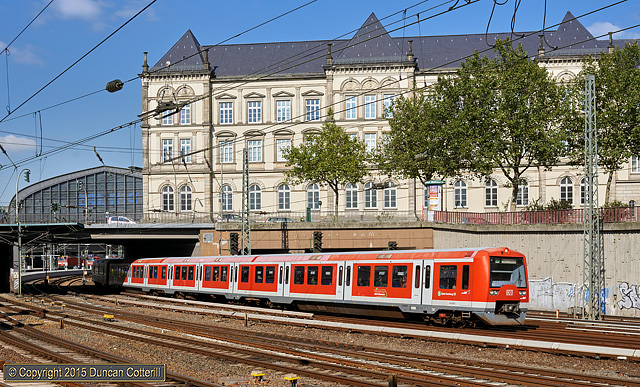
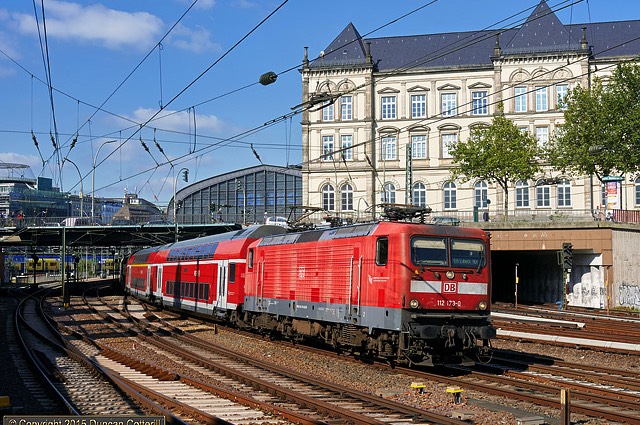
Third Track
After two hours, a loco hauled train finally left Hamburg Hbf on the third track over, making a better composition than the usual departures on the nearer tracks.112.173 made its second appearance of the day, this time on with RE21418, the 13:04 to Lübeck.
That impressive building behind the loco is the Museum für Kunst und Gewerbe (Museum of Culture and Industry).
Class 472
A class 472 EMU dating from the mid-1970s approached Hamburg Hbf with an S11 service on the afternoon of 1 October 2015. Unit 472.003 was working train 47375 from Altona to Barmbek.The train was crossing over the exit from the tunnel under the city centre opened in 1981.
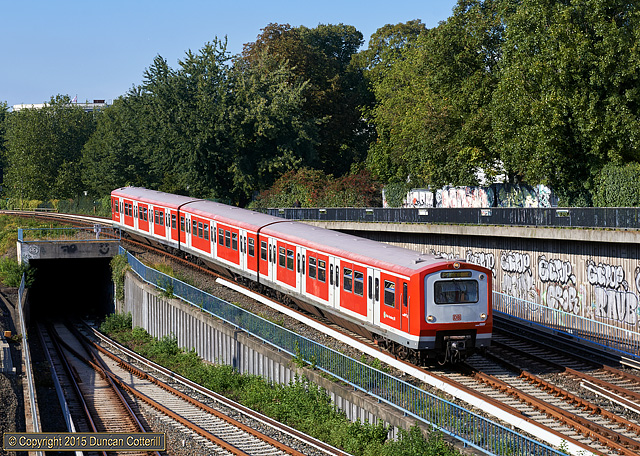
HAMBURG TO HUSUM VIA LÜBECK & KIEL
25 September 2015Not the obvious route to take but there was method in my madness. Two class 218 propelled regional services set off from Kiel at 05:13 and 06:04 on Mondays to Fridays, taking the un-electrified single-track line to Lübeck via Plön and Eutin then continuing under the wires to Hamburg Hbf. Both trains return via the same route in the afternoon, leaving Hamburg at 16:44 and 17:44 on Mondays to Thursdays and 15:44 and 16:44 on Fridays. I took RE21492, the 15:44 from Hamburg Hbf all the way to Kiel Hbf, a double-deck push-pull set hauled by Kiel depot's 218.453.
Once out of the suburbs, it was a very pleasant run through the countryside with gentle rolling hills, farmland and attractive villages. There was more woodland than I expected and the lakeside section near Plön was very nice. There didn't seem to be many promising photo locations though, too much lineside vegetation. The 112 and 143 worked regional services gave way to class 648 DMUs beyond Lübeck. DB seems to have a huge fleet of these for working regional services on un-electrified lines in Schleswig-Holstein and, apart from the 218 on my train, they were the only diesel traction seen all the way to Kiel and on to Husum.
Kiel Hbf has an attractive overall roof but most of the loco worked trains I saw were push-pulls with the loco at the wrong end. The exception was IC2225, a long train with the loco, 101.084, too far along the platform to feature the roof in a picture. Two Kiel - Neumünster RBs were seen, both push-pulls powered by class 143 electrics, 143.311 and 143.860 being the locos in question. I hadn't realised that these services were still loco and coaches.
My journey from Kiel continued on RE21226 to Husum, one of the ubiquitous DB class 648 DMUs. I got the impression that we flew along but it could have just been the combination of a low floor unit and rough-riding. After climbing out of Kiel past the depot (lots of 112s or 143s visible but nowt else of interest) the line continued through pleasant countryside to Osterrönfeld, south of Rendsburg, where it joined the electrified Hamburg - Flensburg line. Shortly afterwards we crossed the Nord-Ostsee Kanal (Kiel Canal) via the spectacular Rendsburg Hochbrücke (high bridge) complete with spiral at the north end. There must be some good shots here.
North of Rendsburg we continued up the Flensburg line through increasingly flat and uninteresting country to Jübek where we branched off onto the single track line to Husum. This line seemed devoid of everything with no stations, no passing loops and no scenery. I'm glad I didn't waste any time trying to photograph freights here when the diversions were on, not that it would have been easy as most trains that came this way ran overnight.
A CLOUDY DAY AROUND HANNOVER
06 October 2015I had a day in the Hannover area prior to travelling to Wernigerode for a visit to the Harz metre gauge lines and had planned to go to Dedensen-Gümmer to photograph the heavy freight traffic. As it turned out, the forecast was for continuous cloud and rain so the day was spent day having a look at the lines to Göttingen and Osnabrück instead, using a Niedersachsen Ticket, excellent value at €23 for the day.
After catching the S-Bahn from the airport to the Hbf, there was just enough time to stuff the case in a left-luggage locker, grab a coffee and board ME82825 to Göttingen, hauled by Metronom's 146.541. Hannover Messe/Laatzen station looked to have some potential for photography although electrification mast spacing could be a problem. The landscape got a lot hillier south of Banteln but most of the potential photo positions looked heavily overgrown. The best possibilities appeared to be morning shots either side of Kreiensen. Quite a few freights were seen during the journey, mainly hauled by modern DB locos with classes 185 and 189 noted. There were also a few locos belonging to independents including 182s and 185s. The most unusual loco seen was 214.001, an Alstom rebuild of a former DB class 212 seen on a northbound freight on the approach to Göttingen.
Another coffee at Göttingen (I'd had a very early start and was beginning to suffer the consequences) and then straight back to Hannover on ME82830 propelled by 146.541. 214.001 and its freight were overtaken at Kreiensen and other sightings were very similar to those on the outward journey. Other Metronom locos seen on Uelzen - Göttingen services were 146.518 and 146.538.
Most of the afternoon was spent travelling to Osnabrück and back, taking RE26290 on the way out, another double-deck set, propelled by 111.131. Again much of the lineside was overgrown and few potential photo locations were noted. Freight traffic seemed just as heavy as on the Göttingen line but the motive power was different with classes 140, 151 and 155 in use as well as the inevitable class 185s. The return journey was on RE26293, hauled by 111.133. Most regional services around Osnabrück appeared to be worked by units belonging to independent operators. Other locos seen on Rheine - Braunschweig REs were 111.091 / 142 / 144 / 215 all push-pulls with the loco always at the Braunschweig end. 146.127 was on a Hannover - Norddeich train, again a push-pull with the loco leading from Hannover.
Darkness Falls
111.142 waited to leave Hannover Hbf with RE26294, the 18:20 from Braunschweig to Rheine, as darkness fell on the evening of 6 October 2015.